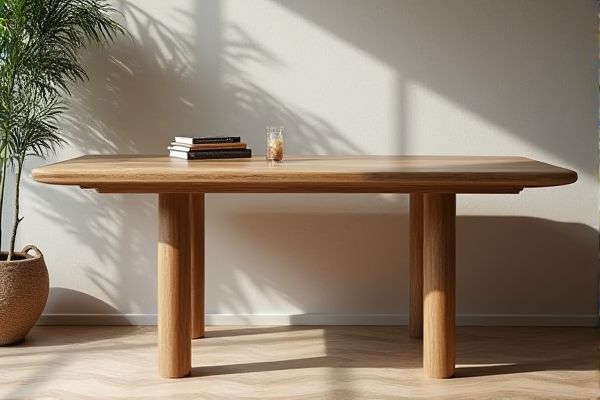
A four-legged table offers sturdy, evenly balanced support ideal for traditional settings, while a pedestal base provides more legroom and a sleek, modern look that can suit smaller spaces. Explore the advantages of both designs to determine which table base best fits Your style and needs in the rest of the article.
Table of Comparison
| Feature | Four-Legged Table | Pedestal Base Table |
|---|---|---|
| Stability | High stability with four separate legs | Stable but may wobble if base is not heavy |
| Legroom | Limited legroom due to corner legs | More legroom with central base |
| Design Style | Traditional and classic | Modern and sleek |
| Weight Distribution | Even weight distributed across four legs | Weight centered on pedestal base |
| Space Efficiency | Less efficient in small spaces | Better space utilization |
| Assembly Complexity | Simple assembly with four legs | May require more complex base attachment |
| Common Uses | Dining tables, work desks | Dining tables, conference tables |
Introduction to Table Base Designs
Four-legged tables offer stability and classic appeal, distributing weight evenly across each corner for balanced support. Pedestal base designs provide greater legroom and flexibility in seating arrangements by centering the support under the tabletop. Your choice depends on space requirements, aesthetic preference, and functional needs for optimal table performance.
Overview of Four-Legged Tables
Four-legged tables provide sturdy, traditional support with evenly distributed weight across each leg, offering stability on various flooring types. Their design allows for versatile placement and easy integration into different interior styles, from classic to modern. You benefit from reliable strength and balanced aesthetics when choosing a four-legged table for your living or dining space.
Key Features of Pedestal Base Tables
Pedestal base tables feature a single central support that maximizes legroom and offers greater flexibility in seating arrangements compared to four-legged tables. These tables often provide enhanced stability through a robust base design, making them ideal for both small and large spaces. The pedestal design facilitates easier cleaning and maintenance by eliminating corner legs that can accumulate dust and obstruct movement.
Stability Comparison: Four Legs vs Pedestal
Four-legged tables provide balanced stability with four points of contact, distributing weight evenly and reducing the risk of tipping. Pedestal bases offer a central support, which can be less stable on uneven floors but provide more legroom and flexible seating arrangements. Your choice depends on the trade-off between maximum stability and convenience in seating.
Space Efficiency and Seating Flexibility
A pedestal base table offers greater space efficiency by eliminating corner legs, allowing more room for chairs and easier movement around the table. Four-legged tables may restrict seating placement due to the fixed leg positions, limiting the number of chairs that can fit comfortably. Your choice depends on whether maximizing floor space and flexible seating arrangements are priorities in your dining area.
Aesthetic Appeal and Design Versatility
Four-legged tables offer a classic, balanced aesthetic that suits traditional and contemporary interiors, providing multiple design options with visible leg structures that enhance room symmetry. Pedestal base tables create a sleek, minimalist look by maximizing legroom and emphasizing the tabletop's design, making them ideal for modern, open-concept spaces. The choice between the two impacts overall spatial perception, with four-legged tables offering visual stability and pedestal bases delivering an airy, streamlined appearance.
Durability and Longevity Considerations
Four-legged tables typically offer sturdy support with evenly distributed weight, reducing the risk of wobbling and enhancing durability over time. Pedestal bases provide greater legroom and a sleek design but may be prone to tipping or wear at the central support if not constructed with high-quality materials. When selecting your table, consider the quality of materials and construction to ensure long-lasting stability and optimal lifespan.
Ease of Maintenance and Cleaning
Four-legged tables offer straightforward cleaning with easily accessible edges and corners, making it simple to wipe down both the tabletop and the legs without obstruction. Pedestal base tables may accumulate dust and debris around the single central support, requiring more detailed attention for maintenance. Your choice depends on whether you prioritize quick cleaning or a sleek design that demands occasional extra effort.
Ideal Use Cases for Each Table Type
Four-legged tables offer stability and are ideal for dining rooms, offices, or informal settings where individual leg space is preferred. Pedestal base tables maximize legroom and suit compact spaces, perfect for small kitchens, cafes, or areas where seating flexibility is essential. Your choice depends on balancing space constraints with the need for foot clearance and ease of movement around the table.
Conclusion: Choosing the Best Table Base for Your Needs
Four-legged tables offer stability and traditional support suitable for heavy or large tabletops, while pedestal bases provide more legroom and a modern aesthetic ideal for smaller spaces. Your choice depends on factors such as room size, style preference, and functional requirements like seating capacity and ease of movement. Evaluating these criteria ensures you select the perfect table base that enhances both comfort and design in your space.
 homyna.com
homyna.com